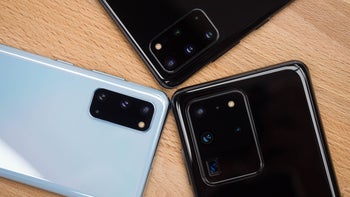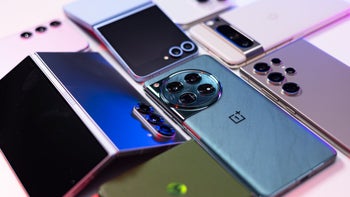Samsung Galaxy S20 vs S20+ vs S20 Ultra camera comparison: no compromises
We may earn a commission if you make a purchase from the links on this page.

Samsung has, again, unveiled a whole triad of flagship phones — the Galaxy S20, Galaxy S20+, and Galaxy S20 Ultra. And while the first two are mostly the same device, just in different packaging, the Ultra goes overkill with a massive camera module, housing different sensors and a whole new zoom system.
But how do these phone cameras compare? And, more importantly, if you choose to buy the $1k Galaxy S20 over the $1.4k Galaxy S20 Ultra, does that mean you will be making a compromise in quality?
We took these three phones out for a spin to answer those questions.
At first, we were concerned that the Galaxy S20 and S20+ will be pulling punches, just so that the Galaxy S20 Ultra shines as the “best” phone camera money can buy. It turns out this is not the case. Even if you get the $1k Galaxy S20, you can still take stellar photos with it, as you can see below. All three phones give us very, very similar photos in many scenarios. And, in some cases, we kind of preferred the results we got with the S20 and S20+ than the Ultra.
With the very first shot, we can see that all three cameras put out very similar shots. We actually need to dig in deep to spot any differences.
In this particular scene, we can see that — while all three phones dealt with the dynamics in the shots great — the Galaxy S20 exhibited the most HDR ghosting issues. See how the building seems to have a slight “aura” glow around the edges of its rooftop? That’s because the phone struggled with accurately stitching up all the different exposures while taking an HDR photo.
When zooming in, we notice that the S20 and S20+ oversharpened the picture just a tad too much, while the S20 Ultra’s details look softer and more natural. In any case, stellar performance from all three phones.
This scene is pretty much proof that we are dealing with the same quality of camera, no matter which of these three phones we reach for. All three shots dealt with the dynamics effortlessly, the sky retained its natural blue colors, the shadows remained visible. Details are clear in all three shots.
If we really dig in deep, we can notice that the reds accents on the Galaxy S20 and S20+ photos are a bit punchier, while the S20 Ultra’s photo made them look a pinch duller. Nothing to fret over, though.
Yet another shot that showcases the subtle differences between the three phones. Again, you will notice that the Galaxy S20 struggled the most with proper HDR stitching — the whole lower half of the skyline has this white-ish gradient as a result of HDR ghosting.
Zooming in on the details, we notice that once again the S20 and S20+ produce sharper details, while the S20 Ultra is softer. In this particular case, we prefer the S20 and S20+’s oversharpening, as it makes the patterns in the facade easier to view without making the whole photo look fake or jagged.
We took all three phones right next to a the petals of a flower and took a snap. Again, we can spot a significant difference between the cameras, plus something weird going on.
So, the shots of the S20 and S20+ look pretty much identical. The phones large sensor and aperture provide for a beautiful, natural bokeh — no Live Focus shenanigans needed here! And then, we move to the S20 Ultra’s shot.
You will notice that the S20 Ultra’s lens appears to be wider — the flower is a bit more distorted, poking towards the camera a bit more than in the smaller phones’ shots. But there’s also a much more dramatic bokeh effect — the S20 Ultra’s depth of field is much shallower, probably thanks to its bigger camera sensor. However, the effect is not necessarily a pleasant one. We favor the shots from the S20 and S20+ phones here, since their narrower angle made the flower look much more natural, and the bokeh is much less distracting than on the S20 Ultra.
The Galaxy S20 is the only one of these three that does not have a ToF camera. Presumably, the ToF sensor would be used to better detect an object’s position, size, and edges, and possibly help for better Live Focus effects (fake bokeh).
So, we wanted to test this out with a quick Live Focus portrait. The results? Absolutely great with all three phones — even strands of hair remain unsmudged. You will notice that the sun goggles of our model did get slightly cropped on the Galaxy S20 sample, though that’s not enough to call “foul” over. Maybe you will need to take a couple of shots at a time, just to be sure that at least one comes out clean.
A couple more things about the portrait — the dynamics on the S20 and S20+ appear to be more dramatic, with more contrast between shadows and highlights. Also, the details are sharper. The S20 Ultra shot looks a bit softer and there seems to be a yellow-ish hue covering the subject’s skin.
All three of these phones have ultra-wide cameras as well. These are great when you are trying to take epic scenery shots or record action-packed videos where you need a wider frame to work with.
How do the three ultra-wide cameras compare? Honestly, we could just say it’s the same camera. These shots can easily go in a blind test and nobody would be able to point out which one comes from what phone.
Well, there does seem to be one very subtle telltale sign, which gives the S20 Ultra away. Just like in scene 2, the Galaxy S20 and S20+ seem to be producing shots with more vibrant, punchy reds, while the S20 Ultra leans to either making reds look duller, or skewing them towards orange ever so slightly.
Of course, the Galaxy S20 Ultra’s main selling point is its zoom on tap. And we can’t have a camera comparison without testing this. We went up to 30x since that’s the limit of the Galaxy S20 and S20+. As expected, the S20 Ultra provided a much clearer and sharper image when zoomed in — the S20 and S20+ zoom becomes grainy, digital, and honestly not very pretty to look at. The S20 Ultra is at least tolerable and perfectly legible.
As you can see, all three phones do a fantastic job. When Night Mode is engaged, the device takes extra snaps at different exposures and produces an image with more dynamics and better-visible detail, of course. And all three may go a bit overboard with oversharpening here and there.
We took these three phones out for a spin to answer those questions.
Summary
At first, we were concerned that the Galaxy S20 and S20+ will be pulling punches, just so that the Galaxy S20 Ultra shines as the “best” phone camera money can buy. It turns out this is not the case. Even if you get the $1k Galaxy S20, you can still take stellar photos with it, as you can see below. All three phones give us very, very similar photos in many scenarios. And, in some cases, we kind of preferred the results we got with the S20 and S20+ than the Ultra.
Of course, the Galaxy S20 Ultra absolutely excels at taking photos at high levels of zoom — that's its main thing, after all. It also has the capability of taking 108 MP pictures thanks to its huge sensor, but the S20 and S20+ are no slouches as well — they have a 64 MP mode (see our 108 MP vs 64 MP vs 12 MP comparison here). But when it comes to normal, everyday photography, you will have a very, very tough time to discern between them. Check out the samples after the break!
Buy Samsung Galaxy S20 from:
Buy Samsung Galaxy S20 Plus from:
Buy Samsung Galaxy S20 Ultra from:
Scene 1: The Theatre
With the very first shot, we can see that all three cameras put out very similar shots. We actually need to dig in deep to spot any differences.
In this particular scene, we can see that — while all three phones dealt with the dynamics in the shots great — the Galaxy S20 exhibited the most HDR ghosting issues. See how the building seems to have a slight “aura” glow around the edges of its rooftop? That’s because the phone struggled with accurately stitching up all the different exposures while taking an HDR photo.
Scene 2: The Shopping Center
This scene is pretty much proof that we are dealing with the same quality of camera, no matter which of these three phones we reach for. All three shots dealt with the dynamics effortlessly, the sky retained its natural blue colors, the shadows remained visible. Details are clear in all three shots.
If we really dig in deep, we can notice that the reds accents on the Galaxy S20 and S20+ photos are a bit punchier, while the S20 Ultra’s photo made them look a pinch duller. Nothing to fret over, though.
Scene 3: The Old Hotel
Yet another shot that showcases the subtle differences between the three phones. Again, you will notice that the Galaxy S20 struggled the most with proper HDR stitching — the whole lower half of the skyline has this white-ish gradient as a result of HDR ghosting.
Zooming in on the details, we notice that once again the S20 and S20+ produce sharper details, while the S20 Ultra is softer. In this particular case, we prefer the S20 and S20+’s oversharpening, as it makes the patterns in the facade easier to view without making the whole photo look fake or jagged.
Scene 4: Macro Shot
We took all three phones right next to a the petals of a flower and took a snap. Again, we can spot a significant difference between the cameras, plus something weird going on.
So, the shots of the S20 and S20+ look pretty much identical. The phones large sensor and aperture provide for a beautiful, natural bokeh — no Live Focus shenanigans needed here! And then, we move to the S20 Ultra’s shot.
You will notice that the S20 Ultra’s lens appears to be wider — the flower is a bit more distorted, poking towards the camera a bit more than in the smaller phones’ shots. But there’s also a much more dramatic bokeh effect — the S20 Ultra’s depth of field is much shallower, probably thanks to its bigger camera sensor. However, the effect is not necessarily a pleasant one. We favor the shots from the S20 and S20+ phones here, since their narrower angle made the flower look much more natural, and the bokeh is much less distracting than on the S20 Ultra.
Scene 5: A Portrait
The Galaxy S20 is the only one of these three that does not have a ToF camera. Presumably, the ToF sensor would be used to better detect an object’s position, size, and edges, and possibly help for better Live Focus effects (fake bokeh).
A couple more things about the portrait — the dynamics on the S20 and S20+ appear to be more dramatic, with more contrast between shadows and highlights. Also, the details are sharper. The S20 Ultra shot looks a bit softer and there seems to be a yellow-ish hue covering the subject’s skin.
Scenes 6 and 7: Ultra-wide angle
All three of these phones have ultra-wide cameras as well. These are great when you are trying to take epic scenery shots or record action-packed videos where you need a wider frame to work with.
How do the three ultra-wide cameras compare? Honestly, we could just say it’s the same camera. These shots can easily go in a blind test and nobody would be able to point out which one comes from what phone.
Well, there does seem to be one very subtle telltale sign, which gives the S20 Ultra away. Just like in scene 2, the Galaxy S20 and S20+ seem to be producing shots with more vibrant, punchy reds, while the S20 Ultra leans to either making reds look duller, or skewing them towards orange ever so slightly.
Scene 8: Epic Zoom
Of course, the Galaxy S20 Ultra’s main selling point is its zoom on tap. And we can’t have a camera comparison without testing this. We went up to 30x since that’s the limit of the Galaxy S20 and S20+. As expected, the S20 Ultra provided a much clearer and sharper image when zoomed in — the S20 and S20+ zoom becomes grainy, digital, and honestly not very pretty to look at. The S20 Ultra is at least tolerable and perfectly legible.
Scenes 9, 10, 11: Night falls
No camera comparison is complete without taking the phones out at night! Samsung has had a Night Mode available on its devices for a while now, enhancing nighttime photography. However, even if you forget to turn it on and just take a snap in Auto mode, you will still get a pretty good shot with plenty of sharp details visible. Here are a few scenes with Night Mode on and off on all three phones:
As you can see, all three phones do a fantastic job. When Night Mode is engaged, the device takes extra snaps at different exposures and produces an image with more dynamics and better-visible detail, of course. And all three may go a bit overboard with oversharpening here and there.
Interestingly enough, in the night shots, the tables have turned when it comes to color. The Galaxy S20 Ultra's colors are just a tad more vibrant than on its smaller siblings — as opposed to how it was ever so slightly duller in daytime pictures.










Things that are NOT allowed: